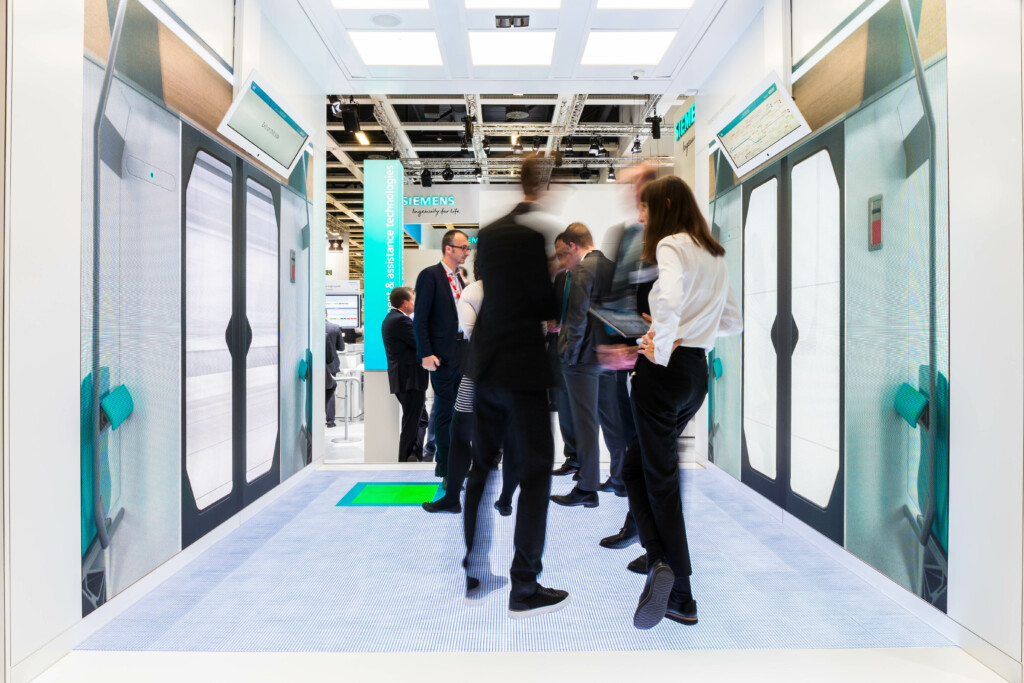Siemens Mobility at Innotrans
Innovative concepts presented virtually
Say we present to you the latest addition to our arsenal of gadgetry? Meet Cube. If it can be put into pixels, Cube can do it with spectacular authenticity. Take, for example, the ICE Cube. The abbreviation
stands for Intercity Express, so it won’t chill drinks, but it does serve up a very cool simulation of the latest in rail travel.






Carpentry and welding still have their place in railway engineering, but those crafts may figure less prominently in satis&fy’s future. There are fewer reasons to reach for a power saw or blowtorch now hat the company has the Cube, a persuasive alternative to conventional showcases. Its streamlined exterior belies the sophisticated interactive AV tech inside. With an edge length of some 3.60 meters, this hexahedron is a wellspring of inspiration for creative ideas. We recently deployed it to wow visitors at InnoTrans, an international fair for things built to ride the rails. Our client Siemens Mobility wanted an eye-catching exhibit to present new railway concepts developed in collaboration with Strukt, a Viennese studio specializing in interaction design. Strukt provided the computer to drive the system and the timetable data for a fictitious city. satis&fy’s job was to present this info at five virtual railway stations.
The Cube simulation performed multiple tasks. It kept ‘passengers’ up to speed via displays and mobile devices. Red and green LED strips indicated closed and open doors. And it pointed the way to
available seating such as wheelchair bays and provided ‘always connected’ service for timetable info, ticketing and the like. In the real world, these functions would also enhance on-board safety by furnishing data to analyze sounds and facial expressions. A single click is all it takes for passengers to report a problem and their location to the conductor.
All this took place on two opposite walls of the Cube featuring 2.5-by-2.5-meter LED screens and the actual displays used on trains. Our displays showed the doors opening and closing and the views seen through the windows when arriving and departing stations. We also conjured a little illusion to put a smile on onlookers’ faces: The simulated windows mirrored their reflections. It was all intriguingly lifelike with speakers rendering the sounds of the train rolling in and stopping, and beacons on the ceiling providing LF connectivity.
Siemens presenters demonstrated this automated, adaptive display for railway stations to show how it provides info such as locationbased directions to elevators on the left or right. They used tablet PCs to jump to scenes of the moving and stationary vehicle and to shuttle to various locations on it. This emulation shoehorned an entire train and railway line with five stations into a room no bigger than an office.
“It was an elaborate job,” says project manager Max Hupp, ‘not only in terms of the digital content, but also in terms of the build. With walls 30 cm thick, we had to find a way to let the heat escape from the large displays. We used natural ventilation to conserve energy, raising the cube two centimeters off the floor to allow cool air to flow in and circulate below it. This reduces the displays’ temperature as the warm air flows out and rises.”
A dry run was conducted at the satis&fy Karben warehouse with the original screens and displays to proof the system. After three days and a little tweaking, it ran as flawlessly as it did shortly thereafter in Berlin.
\ Photos: Jonas Janczyk \


YOUR IDEA IS OUR CHALLENGE!
In the beginning there is always an idea. Then you need innovation enablers, people who think ahead and implement ideas: Our interdisciplinary teams combine classic event disciplines such as light, sound, video and trade fair construction with innovative trends such as virtual reality, 3D staging and new digital developments.
The digital world has become an essential part of our everyday life. One more reason to deal with digital solutions for live communication. satis&fy further develops technologies and gives new ideas a helping hand. We explore the future potential of digital applications and drive forward promising developments.
Try us!
Contact: Max Hupp
We are contact for:
- digital product presentations
- digital shopping experiences
- interactive systems
- customized, multimedia products
- 360° mixed reality experiences
- digital signage
- haptic solutions
- Products with digital components
- unique visual experiences
- AR/VR Experiences
- disruptive approaches
- Try-on solutions

